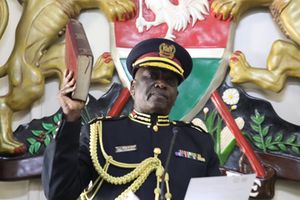To wish hardship upon Kenyans is the worst form of witchcraft

President William Ruto and Deputy President Rigathi Gachagua chat as they leave at Uhuru Gardens on October 10,2022 during Mashujaa Day.
How does society determine that an event is attributable to malign spells inflicted through witchcraft, and that it emanates from (a) particular sorcerer(s) or sorceress(es)?
Alas, the answer is not to be found in our statutes, even though there is a fully-fledged Witchcraft Act, Cap 67, of 1967. It’s most salient feature is its scrupulous ontological skepticism welded to a firm consequential preoccupation.
The drafters qualify references to witchcraft in ways that highlight utter incredulity about the existence of such capability.
Thus, the entirety of the brief statute is replete with references like “any person who holds himself out as..”, “or who pretends to exercise any kind of supernatural power...”, “so-called witchcraft”, and so forth.
On the other hand, the law makes it clear that whether or not such capability actually exists in fact, people claiming to possess it actually do wreak social havoc by threatening all manner of deleterious manifestations of their power.
Thus, it proscribes the use of witchcraft, sorcery, enchantment or other supernatural power to cause fear, annoyance or injury to another in mind, person or property.
The Act’s antecedents are Cap 25 of 1948, and No. 23 of 1925, and thus traces its way to resistance to colonial rule, when the might of empire was frequently thwarted by ferocious natives galvanised by traditional prophets and seers.
Indeed, the banishment of various leaders of the earliest resistance, including the entire Talai clan of the Nandi and Kipsigis, began with the enactment of this ordnance, and subsequent designation of various persons and groups as sorcerers and other practitioners of witchcraft.
Colonialists were afraid, but unwilling to acknowledge the reality of traditional authority. Even so, over time, many of them embraced the African occult, as documented by Janet McIntosh in Unsettled: Denial and Belonging Among White Kenyans.
Using the law and imperial perspectives to understand witchcraft is guaranteed futility. African social understandings of witchcraft simply implied actively malevolent behaviour of certain antisocial individuals, not the confounding exercise of charismatic power and traditional authority.
The distinguishing features of sorcerers and witches was antipathy, disengagement and demonstrated or inferred malign intent. This is behaviour that extended outside the bounds of tolerable contrarianism.
Every community has its oppositionists and gadflies. By and large, they criticise and vigorously dispute dogma and received truths, but nevertheless live fairly compliant lives, participate in communal life and eschew subversion.
Practitioners
The practitioners of witchcraft, on the other hand, are reputed to have anomalous anatomy, even if only figuratively.
They are said to have “blackened hearts” owing to their perpetual state of bilious disenchantment with the well-being of their fellows. They are irrevocably disengaged from the commonwealth and evince a fiery vexation at the notion of contentment for any number of people.
Most critically, these people harbour a hearty disaffection with popular aspirations, and are heavily invested in the vigorous pursuit of ways and means of inflicting misery upon one and all.
They rejoice at misfortune, are reflexively envious, do nothing to succour the troubled, and everything to afflict the thriving.
Before modern science illuminated truths about the causes and nature of various pestilences, supernatural malignity was the best operating hypothesis.
Consensus was that certain characters accursed with the evil eye, black hearts and rampant misanthropy had incanted dire maledictions to enlist demonic agencies in terrorising, tormenting and exterminating their neighbours.
This hypothesis would be buttressed by intent to be inferred from the suspects’ reclusiveness, disengagement and implicit malice.
If there was widespread grievance, outcry or other expression of discomfort with these fearsomely weird persons, the community would initiate the due process of excommunication , culminating in an event of the kind I related last week.
There is a point beyond which all communities’ tolerance for transgressive behaviour collapses. Ideological commitment to the suffering of the many as a basis for political mobilisation is a form of modern sorcery and black heartedness.
The glee with which certain political formations relish popular agony about the cost of living is desperately malevolent.
The exuberant rejoicing at the thought of fiscal crisis and delirious excitement with the imagined prospect of debt default is plainly pernicious. There is, presently a fully-fledged political enterprise bristling with impatience as it awaits all manner of disasters to befall Kenyans.
This outfit actively wish for an Armageddon-esque sequence of calamities and a cruel, dystopian aftermath, just to claim that the government has failed.
They casually express their wish for state failure and the dismemberment of the republic to vindicate an irrational preoccupation with national sabotage in the name of political competition.
To wish the people of Kenya hardship and suffering as an opportunity to pursue power exhibits deplorable politics.
Aligning such malevolent aspirations with a political platform evinces a black-heartedness that typifies the most bilious wachawi. There is no civilised excuse for such diabolical atrocity.
Mr Ng’eno is an advocate of the High Court.





